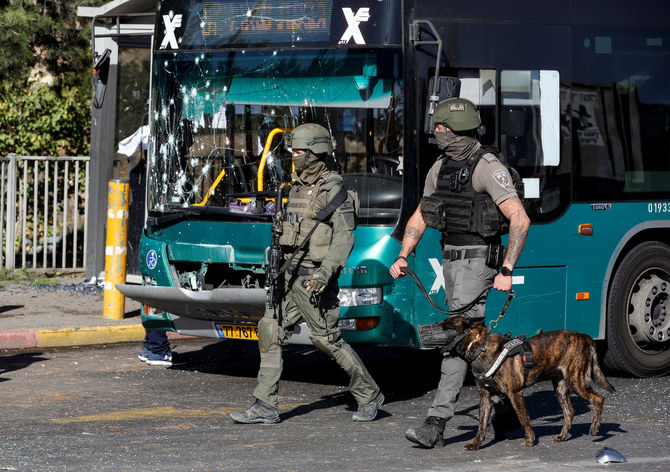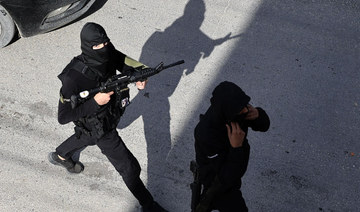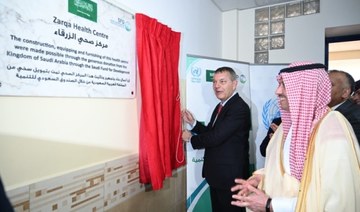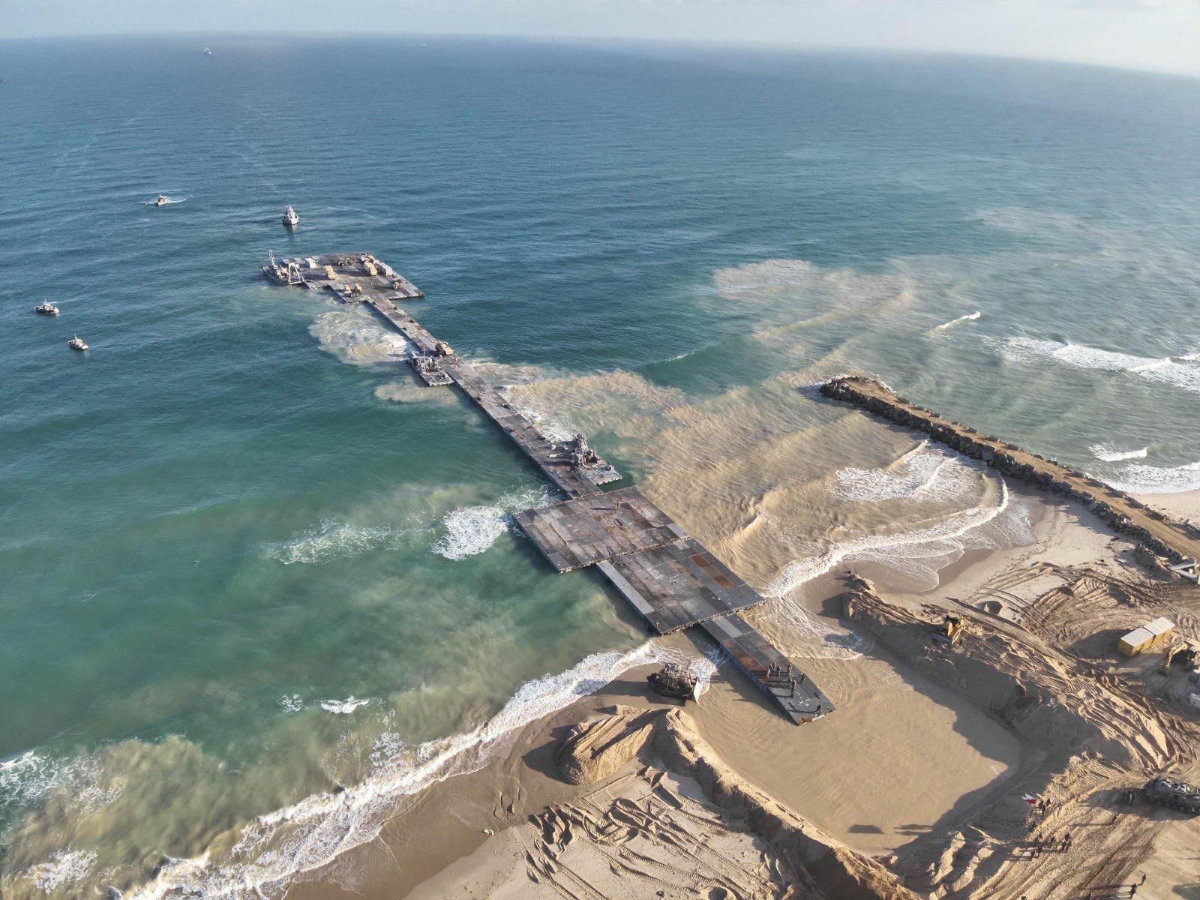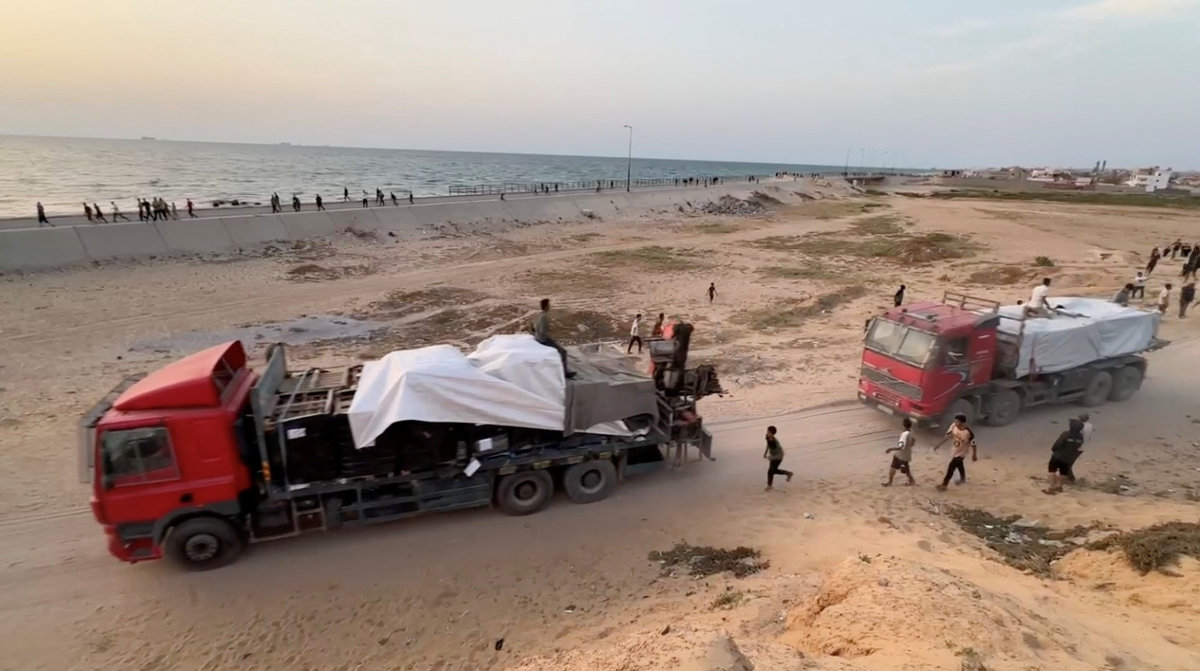RAMALLAH: Two bombs on Wednesday exploded at bus stops on Jerusalem’s outskirts killing a 16-year-old Israeli boy and wounding at least 18 other people.
Police blamed the initial blast, during morning rush hour, on an improvised device at a bus station near the city exit. The second — about 30 minutes later — hit a bus stop near a settlement east of the city.
The first blast, police said, was caused by an explosive device placed inside a suitcase at the bus station crowded with passengers and soldiers.
The area was condoned off after the explosions and police deployment across the city was increased. The main entrances to Jerusalem were closed and a manhunt was launched to try and track down the perpetrators. The police had received no warning about the attacks.
While the Israeli security services said they had no idea who carried out the bombings, sources said the operation was conducted by the Al-Aqsa Martyrs Brigades, the military wing of the Fatah movement.
The security services believe that the perpetrator or perpetrators carried blue Israeli IDs allowing their entry into west Jerusalem.
Israeli ultra-nationalist lawmaker, Itamar Ben-Gvir, one of Benjamin Netanyahu’s likely coalition partners, demanded tough action, suggesting that security forces should go “house to house in search of guns and restore our deterrence power.”
So far, no group has claimed responsibility for the attacks.
Hamas spokesman Abdulatif Al-Qanoun said the organization, “blesses the operations, considering that they come within the framework of the continuous response to the storming of Al-Aqsa Mosque, its Judaization, and attempts to divide it.
“It is the result of the crimes of the occupation and settlers against our people and Al-Aqsa. It reaffirms with conclusive evidence that more heroic operations will only meet Israeli terrorism with various means and different regions,” he added.
Al-Qanoun said that the Israeli occupation was now, “reaping the price of its crimes and aggression against our people and the Al-Aqsa Mosque, which we have repeatedly warned about. The anger of Al-Aqsa will explode and spread in all regions.”
Tariq Ezzedine, spokesman for the Islamic Jihad movement, said the attack sent a message to Israeli leaders and settlers that, “all the criminal policies of your government will not protect you from the blows of the Palestinian people’s resistance.”
Thirty Israelis have been killed by Palestinians since the beginning of the year, while the Israeli army has killed 148 Palestinians in the West Bank and 52 in the Gaza Strip.
Tensions are running high in the northern West Bank city of Jenin which has seen a heavy police deployment after gunmen from the Jenin Brigade seized the body of a young Druze from Haifa who died on Tuesday evening in a traffic accident in the city.
They demanded to exchange his body for the bodies of Palestinians killed by the Israeli army which is still holding them.
Tiran Fero, an Israeli Druze, was involved in a “serious road accident” in the northern West Bank, the Israeli military said.
An Israeli security official said, such an exchange would not take place.
Israeli Prime Minister Yair Lapid said: “If Tiran’s body is not returned, the kidnappers will pay a heavy price.”
UN sources confirmed to Arab News that the UN envoy to the Middle East peace process, Tor Wennesland, and the Palestinian Authority are trying to diffuse the situation. However, there has been no progress in efforts to recover Fero’s body.
Former Israeli minister Ayoub Kara said he was in talks with officials in the Gulf states to pressure the Palestinian Authority to move quickly to return the body.
Israeli military sources said that the army was getting ready for the possibility of storming the Jenin camp to retrieve the body.
Meanwhile, the Palestinian Health Ministry announced the death of Ahmed Shehadeh, 16, who died after a bullet fired by Israeli soldiers pierced his heart during the storming of Nablus on Tuesday night.
A large number of forces, accompanied by a bulldozer, stormed the eastern area of Nablus in preparation for a settlers’ visit to Joseph’s Tomb. It led to heavy clashes in which the Israeli forces opened fire and used stun grenades and tear gas on protesting Palestinians. Three people were injured.
The Palestinian Foreign Ministry condemned the killing of Shehadeh, calling it an extension of a series of extrajudicial killings and an integral part of the Israeli targeting of Palestinian children.
Eyal Alima, an Israeli military analyst, told Arab News that the Jerusalem bombing represented a failure by the Israeli security services to anticipate or prevent it.
“I do not think that it is an indication of a return to large-scale bombing operations, as was the case during the second intifada because the Israeli army controls the land in the West Bank and Jerusalem, and there is no strong military structure for the Palestinian organizations that would enable them to manufacture bombs and send bombers to Israel.”
Alima described the situation in the West Bank as heading toward an escalation of violence, especially if the Israeli army launched a military operation in the Jenin camp to recover the body of the Druze youth.



